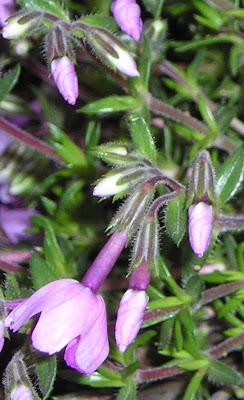 In the spring time one ground cover really stands out due to its prolific flowering. Creeping phlox or Phlox stolonifera really punches out the color for a couple weeks in spring then fades into a nice lush and green carpet of foliage. You can use it on slopes, around mailboxes or as a low growing front border plant. It has many options. As many other ground covers are, this one is easy to propagate. I took a small cutting last summer from a plant at my in-law's house. I popped it in some dirt and kept it watered through the Drought of '07. When fall came and the rains returned I forgot about it. I left it sitting in its little pot in the front garden area.
In the spring time one ground cover really stands out due to its prolific flowering. Creeping phlox or Phlox stolonifera really punches out the color for a couple weeks in spring then fades into a nice lush and green carpet of foliage. You can use it on slopes, around mailboxes or as a low growing front border plant. It has many options. As many other ground covers are, this one is easy to propagate. I took a small cutting last summer from a plant at my in-law's house. I popped it in some dirt and kept it watered through the Drought of '07. When fall came and the rains returned I forgot about it. I left it sitting in its little pot in the front garden area.  Last week I rediscovered this wayward cutting to find lots of green growth and a good deal of budding. I didn't take a picture of it last year but it was an unbranched cutting that was approximately 3-4 inches long. I don't remember if I used rooting hormone or not, and I don't think it's necessary, but it may speed things up a little.
Last week I rediscovered this wayward cutting to find lots of green growth and a good deal of budding. I didn't take a picture of it last year but it was an unbranched cutting that was approximately 3-4 inches long. I don't remember if I used rooting hormone or not, and I don't think it's necessary, but it may speed things up a little.I'm not sure what the exact variety is, or even if there is one for this particular plant ('Candy Stripe' comes to mind, but I don't have any way to know for sure) other than the botanical name: Phlox stolonifera. The word stolonifera is used in many plant names and indicates that the plant has a rooting stem or stolon. Another example of this would be a Red Twig Dogwood whose botanical name is Cornus stolonifera. Plants like this are prime candidates for propagation since rooting is a natural method of reproduction for them.

 In the photo above you can see the sprig and its progress. Once I took the phlox out of its pot to transplant it I found that the root system went all the way to the bottom of the pot. In the picture below you can see all its flower buds. Not bad for a little sprig!
In the photo above you can see the sprig and its progress. Once I took the phlox out of its pot to transplant it I found that the root system went all the way to the bottom of the pot. In the picture below you can see all its flower buds. Not bad for a little sprig!
I took some pictures of the torrential downpours we had today. I'll have them up sometime this weekend!
